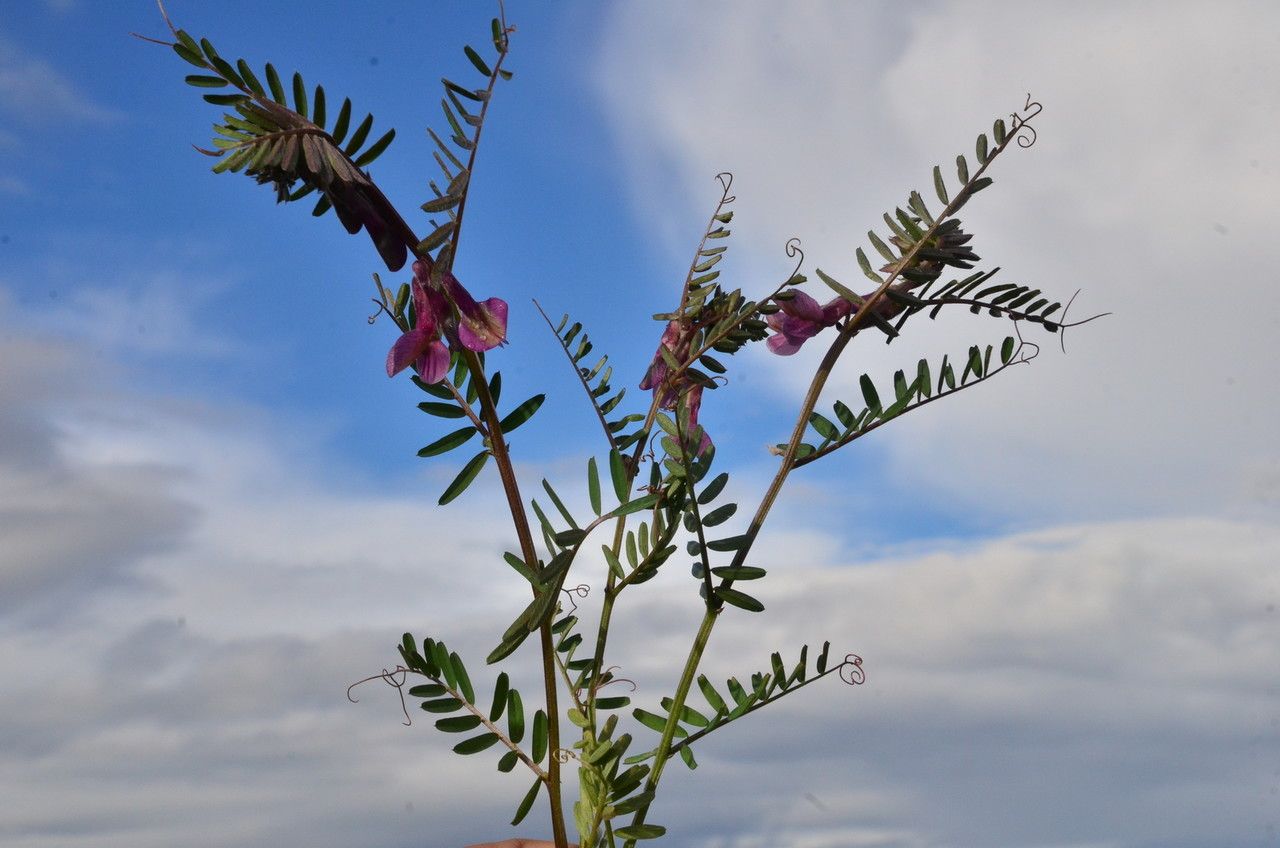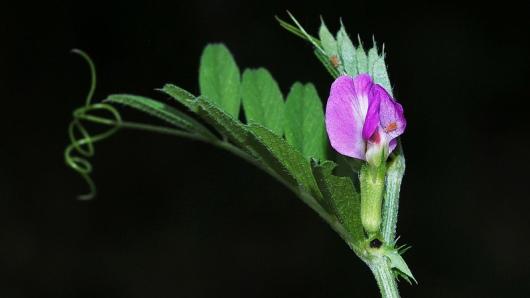Common Vetch
vicia sativa
Also known as: ["Spring Vetch","Spring Vetchling"]
Overview
A climbing annual legume with compound leaves and small purple flowers, often used as a cover crop or forage plant.
Benefits & Perks
["drought tolerant","wildlife attractant (bees, butterflies, birds)"]
Botanical Classification
| Phylum: | Magnoliophyta |
| Class: | Magnoliopsida |
| Order: | Fabales |
| Family: | Fabaceae |
| Genus: | Vicia |
| Botanical Name: | Vicia sativa |
Plant Characteristics
Basic Information
- Category: Herbs & Weeds
- Suitable Location: garden bed or container in a sunny to partially shaded area
- Suitable For:
- Is Weed: No
- Allergenicity: low
Environmental Needs
- Climate: {"temperatureRange":"5–30°C"}
- Hardiness: {"zones":"3–9"}
- Misting: rarely required
- Drainage: Moderate to fast-draining.
- Soil Type: Well-draining loamy soil with added organic matter; can tolerate poor soils.
Maintenance Level
- Maintenance Level: low
- Toughness Level: moderate
- Pruning Frequency: As needed; typically after flowering or in early spring.
- Pruning Intensity: Light to moderate; avoid heavy pruning unless necessary to control size.
Care Details
Ideal Sunlight Coverage:
Full sun (6–8 hours/day); tolerates partial shade but may produce fewer flowers.
Sunlight Tolerance Tips:
Acclimate seedlings gradually to full sun; protect from intense midday sun in hot climates; ensure adequate airflow to prevent fungal growth.
Care Requirements
Care Difficulty
easyeasy
Sunlight
full sun to partial shade
Rotate plants for even light exposure; use shade cloth in extreme heat; avoid placing near reflective surfaces that intensify light.
Watering
every 7–10 days during active growth, reduce in winter
Water thoroughly but infrequently; ensure good drainage; avoid wetting foliage to prevent fungal issues.
Soil
well-drained, loamy soil with moderate fertility
pH: Slightly acidic to neutral (pH 6.0–7.0).
Avoid heavy clay soils; ensure good aeration; test pH if issues arise.
Temperature
Prefers cool to moderate temperatures (60–75°F/15–24°C); tolerates frost but may struggle in prolonged heat.
Monitor temperature fluctuations; adjust watering based on heat; protect from frost if needed.
Fertilizing
every 4–6 weeks during growing season
Apply fertilizer after watering to prevent root burn; stop fertilizing before flowering to encourage blooms; flush soil occasionally to prevent salt buildup.
Propagation
Methods
Seed propagation is most common; can also be propagated by stem cuttings in spring.
Step-by-Step Propagation Guide
- Prepare medium.
- Sow seeds or take cuttings.
- Maintain moisture.
- Provide warmth.
- Transplant once established.
Best Time: Spring or early summer when temperatures are mild and growth is active.
Environment
Warm (65–75°F/18–24°C), humid, and bright but indirect light.
Medium
Well-draining seed starting mix or a mix of peat and perlite.
Hormone
Not typically required for seeds; rooting hormone can aid stem cuttings.
Timeline
Seeds germinate in 1–3 weeks; stem cuttings root in 2–4 weeks.
Tools Needed
Seed trays, pots, rooting hormone (optional), misting spray bottle, heating mat (optional).
Quick Tips
Keep soil consistently moist but not waterlogged; provide bottom heat for faster germination; thin seedlings as needed.
Pruning & Repotting
Pruning Guide
Method
Snip off dead or yellowing leaves; trim back overgrown stems to encourage bushier growth.
Pruning Plan
Minimal pruning needed; focus on removing dead or damaged growth to maintain vigor.
Tools
Pruning shears, scissors, or sharp knife.
Checklist
Sanitize tools; remove dead/damaged parts; trim selectively; clean up debris.
Repotting Guide
Best Season
Early spring before new growth begins.
Pot Size
One size larger pot (e.g., +2 inches in diameter).
Method
Gently remove plant; trim any circling roots; place in a slightly larger pot with fresh soil; water thoroughly.
Suggestions
Repot only if the plant becomes root-bound or outgrows its container; typically every 2–3 years.
Checklist
Choose appropriate pot; prepare new soil; handle roots carefully; water after repotting.
Advanced Care Tips
Watering Mastery
Watering Checklist
Check soil moisture; water deeply; ensure drainage; avoid wetting leaves.
How to Apply Water Properly
Water at the base of the plant, ensuring moisture reaches the root zone; allow excess water to drain away; water early in the morning to minimize evaporation.
Watering Schedule Tips
Water deeply once the top inch of soil is dry; reduce frequency in winter to prevent root rot.
Soil Improvement
Add compost or well-rotted manure for fertility; mix in perlite or sand for drainage; ensure organic matter is well-decomposed.
Temperature Stress Management
Signs of Temperature Issues
Yellowing leaves (cold stress); wilting or scorching (heat stress); reduced flowering.
Cold Stress
Slows growth; may cause leaf drop; roots can become waterlogged in cold, wet soil.
Solution: Provide frost protection in cold climates; ensure well-draining soil to prevent root rot; avoid overwatering.
Hot Stress
Leaves may wilt, scorch, or drop; flowering may be reduced; growth may stagnate.
Solution: Provide partial shade during peak heat; increase watering frequency; use mulch to retain soil moisture.
Fertilizing Guide
Fertilizing Checklist
Check fertilizer type; dilute properly; apply during active growth; avoid winter feeding.
Fertilizing Method
Use balanced liquid fertilizer diluted to half strength every 4–6 weeks during growing season; avoid fertilizing in winter.
Common Problems & Solutions
Toxicity Warning
Cats
Slightly ToxicCats may experience gastrointestinal distress if they consume significant amounts of Vicia sativa. The plant's lectins and other compounds can irritate the digestive tract and cause discomfort.
⚠️ Symptoms:
🌿 Toxic Parts:
⚡ Toxic If:
if eaten in large quantities
Dogs
Slightly ToxicIn dogs, ingestion of large amounts of Vicia sativa can lead to gastrointestinal upset due to the presence of lectins and other bioactive compounds. These substances can disrupt normal digestive processes.
⚠️ Symptoms:
🌿 Toxic Parts:
⚡ Toxic If:
if eaten in large quantities
Humans
Slightly ToxicVicia sativa, commonly known as common vetch, contains lectins and other compounds that can cause gastrointestinal distress if consumed in large amounts. These compounds interfere with nutrient absorption and can lead to digestive upset.
⚠️ Symptoms:
🌿 Toxic Parts:
⚡ Toxic If:
if eaten in large quantities
Frequently Asked Questions
Q: Is Vicia sativa edible?
A: Yes, but it should be cooked thoroughly to reduce toxicity.
Q: Does Vicia sativa attract wildlife?
A: Yes, it attracts bees, butterflies, and birds.
Q: Can Vicia sativa be used as a cover crop?
A: Yes, it is commonly used to improve soil fertility and suppress weeds.
Quick Reference
| Family: | Fabaceae |
| Care: | easy |
| Light: | full sun to partial shade |
| Water: | every 7–10 days during activ |
Get Expert Care Tips
Download the Plantious app for personalized care reminders and plant identification!
Google Play App Store








